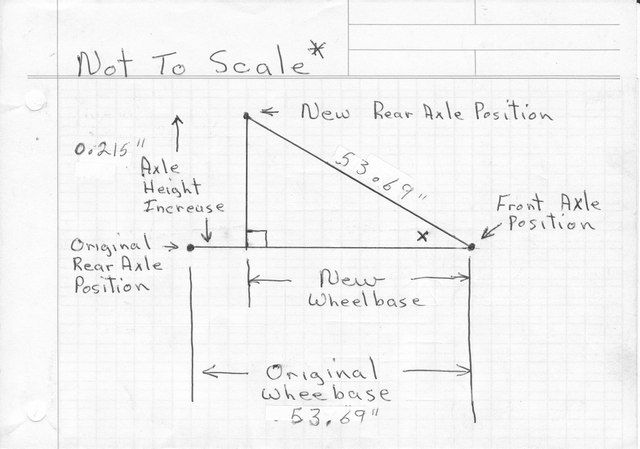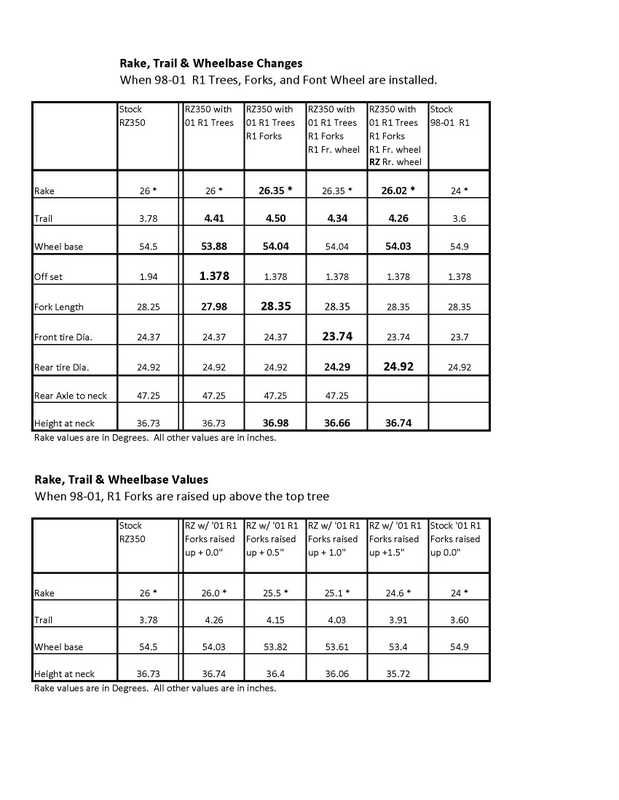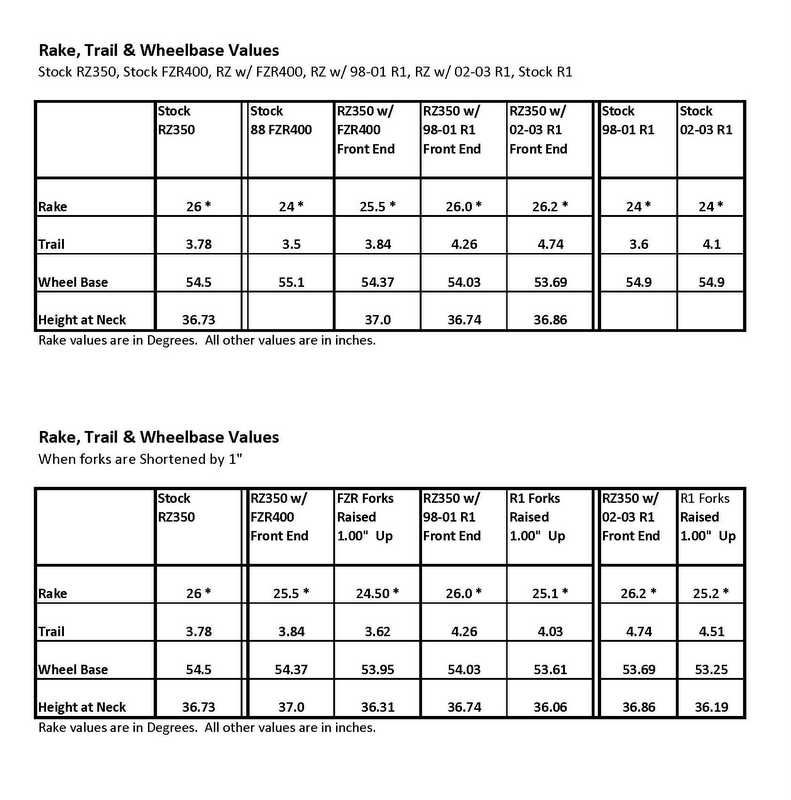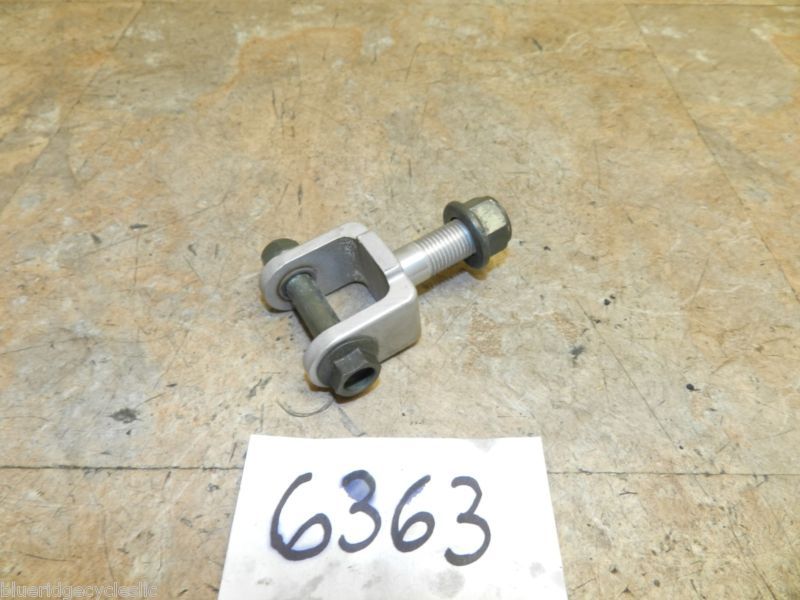Calculating Rake and Trail for an RZ350 with 2002/03 R1 Forks, Trees and Wheels.
using the RB Racing Rake and Trail calculator.
http://www.rbracing-rsr.com/advchoppercalc.html" onclick="window.open(this.href);return false;
The rake and trail calculator was not designed to compensate for changes to offset, or wheel diameter,
and it required some manipulation, to have it account for these changes.
In this write-up, I will try to explain the reasons for the assumptions that I made,
and I've also included all my measurements and calculations.
It make for pretty boring reading, so feel free to skip down to the charts, where I list the final results.
I started out by putting stock RZ info into the calculator:
Rake, 26*, from the manual
Wheelbase, 54.5", from the manual
Offset, 1.94', measured
Fork Length, 28.25", measured
Front Tire, 24.37" OD, from Bridgestone site, BT45 info
Rear Tire, 24.92" OD, from Bridgestone site, BT45 info
With this info, the calculator gave me a trail measurement of 3.78", (the same trail value as in the Manual)
It also gave me 2 more
'Really Important' dimensions.
The distance between the rear axle and the top of the steering head (
47.25")
The distance from the ground to the top of the steering head
(36.73')
Both of these dimensions were useful in manipulating the program.
For me it helped to think of the bike as a large triangle, with the 3 corners being the rear axle, the front axle, and the top of the steering head.
CHANGING FORK OFFSET
Imagine the stock RZ with both wheels on the ground, firmly fixed in space so that the frame can't move.
Remove the forks and front wheel.
Then remove the RZ tree (1.94" offset), and replace it with the R1 tree (1" offset)
Re-install the forks, (so that they are sticking way up above the top tree),
put on the front wheel, and then lower the forks until the wheel touches the ground,
The rear wheel, frame, and top of the steering head, have not moved,
so there is only 1 fork length possible, and this is going to result in 1 wheelbase.
Experimenting with the Rake & Trail calculator, I found that, yes, there is only 1 combination of Fork Length & Wheel-base,
that retains the
"original RZ Height at the steering head"(36.73"),
and the
"original RZ length from rear axle to the top of the steering head"(47.25").
Basically, it's a trial & error approach, until you hit the correct combination.
Changing the offset to 0.09843" (25mm), in the calculator, gave the following results:
- Rake stayed at 26*
- Fork Length decreased to 27.79"
- Wheelbase decreased to 53.44"
- Trail increased to 4.85"
CHANGING FORK LENGTH
At this point, I can use the Rake & Trail calculator as it was intended.
I can install the longer R1 front forks (28.35").
Changing the fork length to 28.35", in the calculator, gave the following results:
- Rake Increased to 26.54*
- Wheelbase increased to 53.69"
- Trail increased to 4.98"
- Height of the steering neck increased to 37.11".
Before calculating changes in Front Wheel Diameter, Enter the New Wheelbase (53.69") and New Rake (26.54*), in the calculator,
CHANGING FRONT WHEEL DIAMETER
Again, imagine my bike, firmly held in place with the tires just touching the floor.
I remove the RZ front wheel (24.37" Dia.), and install the R1 wheel (23.74" Dia.)
The front tire is now 0.63" smaller.
In order to maintain the same rake, when the bike is dropped back on the ground, the rear tire also needs to have a 0.63" smaller diameter,
Changing the front wheel diameter to 23.74", in the calculator, gave the following results:
- Rake stayed at 26.54*
- Wheelbase stayed at 53.69"
- Trail decreased to 4.83"
- Rear tire decreased to 24.29"
- Height of the steering neck decreased to 36.79".
CHANGING REAR TIRE DIAMETER
When the front tire diameter was decreased by 0.63", the rear tire diameter needed to decrease, by the same amount, to 24.29", in order to keep the rake constant.
The new 180/55-17 rear tire diameter is 24.72", which is 0.43" larger, than the "calculated" rear tire diameter.
This will raise the rear axle by 0.215" (half the diameter).
Again, think of the bike as a triangle, rear axle, front axle, and top of the steering head.
Assume that the front wheel is fixed, so it can't move.
When I raise the rear axle by .215", and the whole bike will rotate around the front axle, and tilt forward.
The distance between the front and rear axles does not change, but the rake will get steeper, and the wheelbase will get shorter.
Using a Right angle Triangle.
The Hypotenuse is the distance between the front axle and the rear axle (original wheelbase).
The Opposite side is the Height increase due to the larger rear wheel.
The Adjacent side is the new wheelbase.

From this information, I can calculate the angle that the bike tilted, and the new wheelbase.
The Sine of angle (x), = the Opposite side / Hypotenuse, = Height increase / Original wheelbase.
Sine (x) = 0.215" / 53.69" = 0,00400447
Angle (x) = 0.23*
Tilting the bike .23*, steepens the rake from 26.54*, to 26.31*.
Now that the angle is known, the new wheelbase can be determined.
The Tangent of angle (x), is the Opposite side / Adjacent side = Height increase / New wheelbase.
Tan 0.23* = 0.215" / New wheelbase.
Therefore:
New wheelbase = 0.215" / Tan 0.23* = 0.215" / 0.0040045 = 53.6896".
Changing the Rear wheel diameter to 24.72", in the calculator, gave the following results:
- Rake decreased to 26.31*
- Wheelbase basically stayed at 53.69"
- Trail decreased to 4.77"
- Height of the steering neck increased to 36.85".
CHANGING FORK LENGTH AGAIN
When I had the final rake, fork length, and wheelbase, in the calculator,
It was simple to change fork length, (raised or lowered in the trees), and get new rake & trail numbers.
Here are the charts, showing results using
2002-03 R1 trees.
The first chart shows the changes to rake and trail, as each new item was installed.
Please note that I made 2 calculations for changes to rear wheel size.
One for the 180/70-17 rear tire, and another for the larger, oem, RZ rear tire
The second chart shows what happens to rake, trail, and wheelbase, when I shorten the forks, (raise the tubes up above the top tree).
In this chart, I started the calculations, assuming that the oem, RZ rear tire was being used.

On the 2002/03 R1 trees, the fork offset is 25mm (1")
On the 1998-01 R1 tree, the fork offset is 35mm (1.38")
More offset will result in less trail.
I went through the procedure again, starting with the new offset of 1.38".
Calculated the new fork length, and wheelbase, needed to keep the rake at 26*
Then lengthened the forks. Which Increased rake, trail. wheelbase.
Then a smaller front tire diameter. Which Decreased the trail
Then the larger rear tire diameter, Which Decreased trail and steepened rake.
Here are the charts, showing results using
1998-01 R1 trees.
In both of these charts I assumed that the oem RZ rear tire diameter was being used.
The first chart shows the changes to rake and trail, as each new item was installed.
The second chart shows what happens to rake, trail, and wheelbase, when I shorten the forks, (raise the tubes up above the top tree).

From these calculations, it seems that installing either R1 front end,
results in very minor changes to the rake angle, and the height of the steering head.
The R1 front end swap does make some bigger changes to the Trail and Wheelbase.
Installing the
98-01 R1 front end, on an RZ, Increases the Trail by
0.5", and shortens the wheelbase by
0.5".
Installing the
02-03 R1 front end, on an RZ, Increases the Trail by
1.0", and shortens the wheelbase by
0.8".
On the R1,Yamaha uses a steeper (24*) rake, to make up for the small offset, and still maintain a fairly small amount of trail.
Using the small offset trees on the RZ, with it's 26* neck rake, results in larger trail values.
Here's some of my thoughts on different ways to steepen the rake and decrease the trail.
- Shorten the forks, But this will lower the bike, and further decrease the already short wheel base.
- Longer shock or shorter dogbones, will raise the rear ride height, steepen rake, decrease trail.
Again, this will shorten the wheelbase by some amount.
- Longer swing-arm will also raise the ride height and change the rake and trail.
- Larger rear tire, will raise the rear end and steepen the rake.
- A Smaller front tire. (and FWIW, I like this idea best)
It will drop the front of the bike down, which will steepen rake and decrease trail.
The smaller diameter front tire will cause a further decrease in trail.
The smaller tire will also provide quicker steering.
My final thoughts.
I make no claim that any of the above information is correct.
It's up to you to evaluate it, and see if it's valid, and/or useful.
Oh, and the 2002/03 R1 trees, wouldn't be my first choice.









